Special Report
America’s 20 Cheapest Cities Where Everyone Wants to Live Right Now

Published:

Each year, millions of Americans relocate to somewhere else in the country, whether it is for retirement, college, or a new job. Yet 2020 offered some Americans a new reason to move — the COVID-19 pandemic, which was declared a national emergency in mid-March. Many people moved away from virus hotspots or left cities because they lost their jobs amid the pandemic. Many Americans likely looked for somewhere they could stretch their savings, relocating to places where the cost of living is relatively low.
To identify America’s cheapest cities where everyone wants to live, 24/7 Wall St. reviewed cost of living, housing affordability, and population growth from migration for 110 U.S. metro areas. We ranked cities based on the net incoming searches relative to outgoing searches for homes in each metro area among prospective buyers on Redfin, a national real estate brokerage, during the first three quarters of 2020 (January through September) as a percentage of the 2019 population. Population data came from the U.S. Census Bureau’s Population and Housing Unit Estimates program.
Though some of the relocation to these cities is likely due to COVID-19, the migration patterns seen in 2020 in many of the metropolitan areas on this list mirror patterns from earlier in the decade, as southern cities continued to grow significantly due to migration. Of the 20 cities where Americans are looking to move, 16 are in the South. Conversely, in many more northern cities, particularly in the Rust Belt area, employment had been on the decline already before the pandemic, likely driving people elsewhere to find economic opportunities. These are the American cities losing the most jobs.
Click here to see America’s cheapest cities where everyone wants to live right now.
Click here to see our methodology.

20. Grand Rapids-Wyoming, MI
> Pct. of potential movers from outside Grand Rapids-Wyoming, MI: 51.5%
> Top area people are searching from: Detroit-Warren-Ann Arbor, MI (34.9%)
> Cost of living: 7.8% less than nat’l avg.
> Median home value: $199,400
> Median household income: $65,739
Grand Rapids, Michigan, is the only Midwestern city to rank among the cheapest cities where Americans are flocking to. Of all those who looked for a home in the Grand Rapids metro area in 2020, slightly more than half, or 51.5%, were from outside the area. Of these potential movers, nearly one-third were from the Detroit metro area as well as other Midwestern cities like Chicago.
Those who look to move to Grand Rapids may be attracted by the area’s relatively low cost of living which can help stretch incomes. The cost of living is 7.8% lower than the nationwide average, yet the median household income is nearly the same as the U.S. median of $65,712.
[in-text-ad]

19. Virginia Beach-Norfolk-Newport News, VA-NC
> Pct. of potential movers from outside Virginia Beach-Norfolk-Newport News, VA-NC: 37.0%
> Top area people are searching from: Washington-Baltimore-Arlington, DC-MD-VA-WV-PA (48.8%)
> Cost of living: 3.0% less than nat’l avg.
> Median home value: $255,900
> Median household income: $69,329
The Virginia Beach metropolitan area around the Virginia-North Carolina border is one of 16 Southern cities on this list. Though the area’s cost of living is lower than the national average, its median household income is over $3,000 higher than the U.S. median. Nearly half of all people searching for homes in Virginia Beach from outside the metro area are from the Washington, D.C. region, which is just 150 miles away.
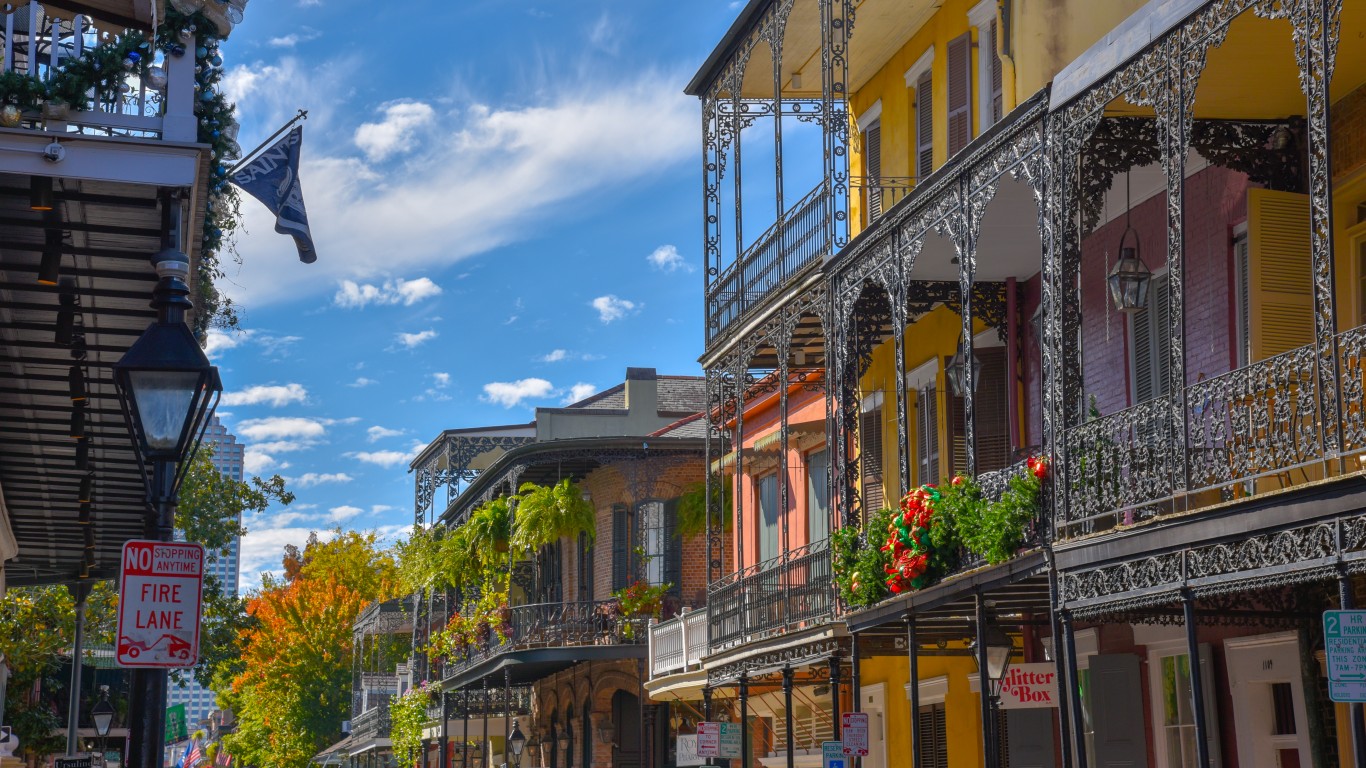
18. New Orleans-Metairie, LA
> Pct. of potential movers from outside New Orleans-Metairie, LA: 30.4%
> Top area people are searching from: Los Angeles-Long Beach, CA (9.6%)
> Cost of living: 5.9% less than nat’l avg.
> Median home value: $211,900
> Median household income: $55,710
Like in most other cities, most people looking on Redfin for a new home in the New Orleans metro area already live there. Still, more than 30% of searches for a place to live in the area are by people living outside New Orleans. Those who were searching for homes in New Orleans came from a variety of places. No one metro area accounted for more than 10% of searches from outside the metro area, with Los Angeles-area residents accounting for the highest share, at 9.6%.

17. Greenville-Anderson-Mauldin, SC
> Pct. of potential movers from outside Greenville-Anderson-Mauldin, SC: 47.3%
> Top area people are searching from: New York-Newark, NY-NJ-CT-PA (18.6%)
> Cost of living: 9.6% less than nat’l avg.
> Median home value: $186,800
> Median household income: $58,621
The Greenville-Anderson-Mauldin metropolitan area is one of several places in the Carolinas that have attracted new residents for years, and continued to do so in 2020. Between 2010 and 2019, the metro area’s population increased by 11.7%, mostly the result of migration. The metro area in 2020 continued to be a popular destination for people looking to relocate, with the New York metropolitan area accounting for the largest share of potential buyers searching for property in the Greenville area.
[in-text-ad-2]

16. Greensboro-High Point, NC
> Pct. of potential movers from outside Greensboro-High Point, NC: 35.9%
> Top area people are searching from: New York-Newark, NY-NJ-CT-PA (25.1%)
> Cost of living: 10.2% less than nat’l avg.
> Median home value: $158,600
> Median household income: $51,770
Unlike many of the metro areas on this list that appear to be popular search destinations for people looking to relocate in 2020, the Greensboro, North Carolina, metro area did not have a particularly high increase in population due to migration through most of the 2010s. From 2010 through 2019, the metro area’s population increased by 4.3% due to net migration, higher than that of many metro areas but lower than almost all those on this list.
Based on data from Redfin, however, the metro area has had a large influx of people looking to relocate there this year. Almost a quarter of people looking to move to Greensboro in the third quarter of 2020 were from the New York metropolitan area.

15. Tucson, AZ
> Pct. of potential movers from outside Tucson, AZ: 51.4%
> Top area people are searching from: Phoenix-Mesa, AZ (21.2%)
> Cost of living: 6.1% less than nat’l avg.
> Median home value: $211,600
> Median household income: $56,169
The majority of people who looked to move to Tucson, Arizona, in 2020 searched from other Western metro areas like Phoenix, Seattle, Los Angeles, and San Francisco. More than half of people who looked for a place to live in the Tucson area in 2020 searched from outside the metro area.
Though incomes are relatively low in Tucson, at just over $56,000, it is also relatively inexpensive. The cost of living in Tucson is 6.1% lower than in the typical U.S. city.
[in-text-ad]
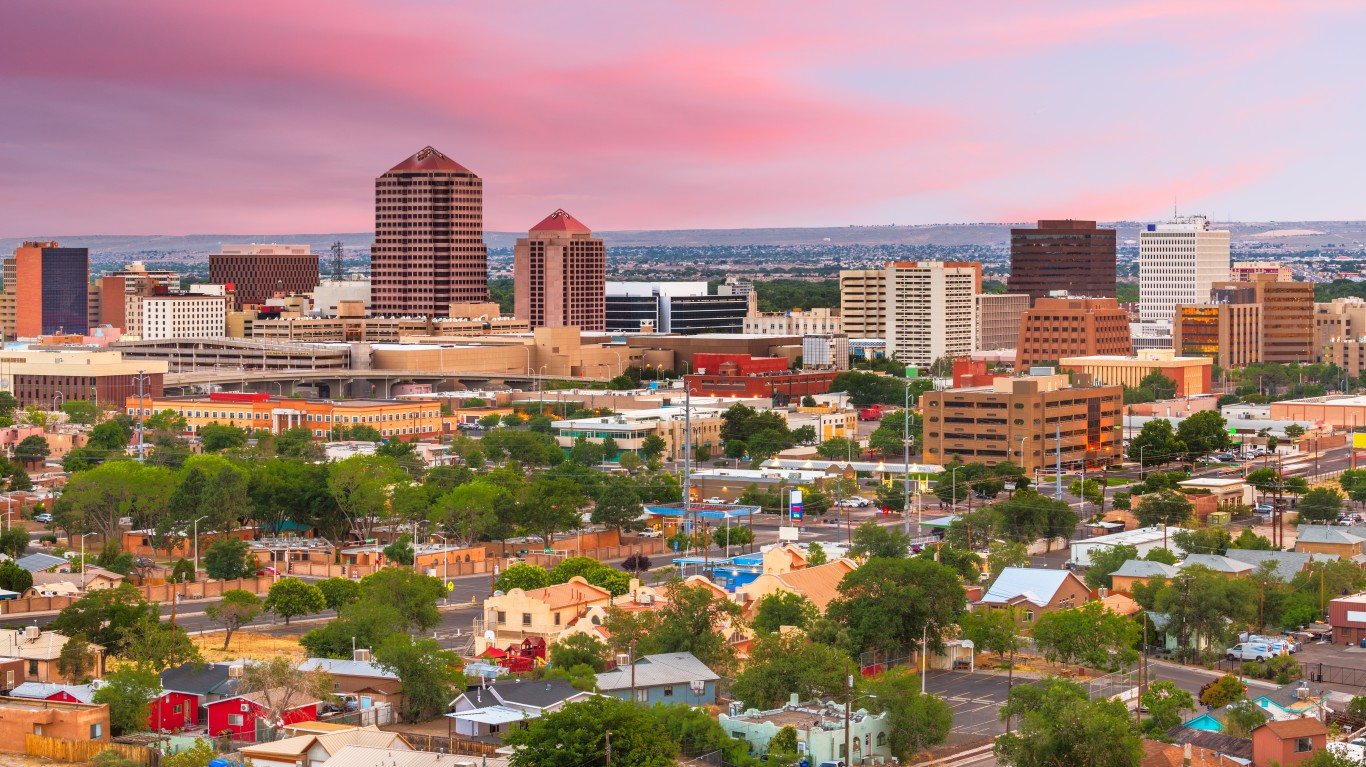
14. Albuquerque, NM
> Pct. of potential movers from outside Albuquerque, NM: 57.2%
> Top area people are searching from: Los Angeles-Long Beach, CA (16.1%)
> Cost of living: 5.8% less than nat’l avg.
> Median home value: $206,000
> Median household income: $58,512
Albuquerque barely had more people moving to it than who moved away from 2010 through 2019. However, according to real estate search data collected by Redfin, thousands more people searched for homes in Albuquerque from elsewhere in the country through the first three quarters of 2020 than were looking to leave the metro area.
Close to 60% of people searching for homes within the metro area came from elsewhere, with the highest share of outside searches coming from the Los Angeles metropolitan area.

13. San Antonio-New Braunfels, TX
> Pct. of potential movers from outside San Antonio-New Braunfels, TX: 42.7%
> Top area people are searching from: Houston-The Woodlands, TX (16.1%)
> Cost of living: 6.1% less than nat’l avg.
> Median home value: $197,600
> Median household income: $62,355
The San Antonio metropolitan area reported a 19% population increase between 2010 and 2019, with the majority of that growth as a result of net migration. San Antonio is a relatively affordable city, with goods and services costing 6.1% less than the national average, while the median household income of $62,355 is just slightly lower than the U.S. median income.
The metro area has been a relatively popular search destination so far in 2020, with the largest share of people looking to relocate to the metro area originating in Houston.

12. Atlanta-Sandy Springs-Roswell, GA
> Pct. of potential movers from outside Atlanta-Sandy Springs-Roswell, GA: 26.0%
> Top area people are searching from: New York-Newark, NY-NJ-CT-PA (37.3%)
> Cost of living: 2.7% less than nat’l avg.
> Median home value: $247,200
> Median household income: $71,742
More than a third of people outside of Atlanta who looked to move to the metro area in 2020 searched from the New York City area. In fact, in seven of the 20 cities on this list, New York City was the top outside metro area where those looking to relocate searched from. New York was one of the cities that was hit the hardest by COVID-19, prompting many New Yorkers to leave.
Atlanta, one of the largest metro areas in the country, has a median household income of $71,742, which is $6,000 higher than the U.S. median. Yet the area’s cost of living is 2.7% lower than the U.S. average.
[in-text-ad-2]
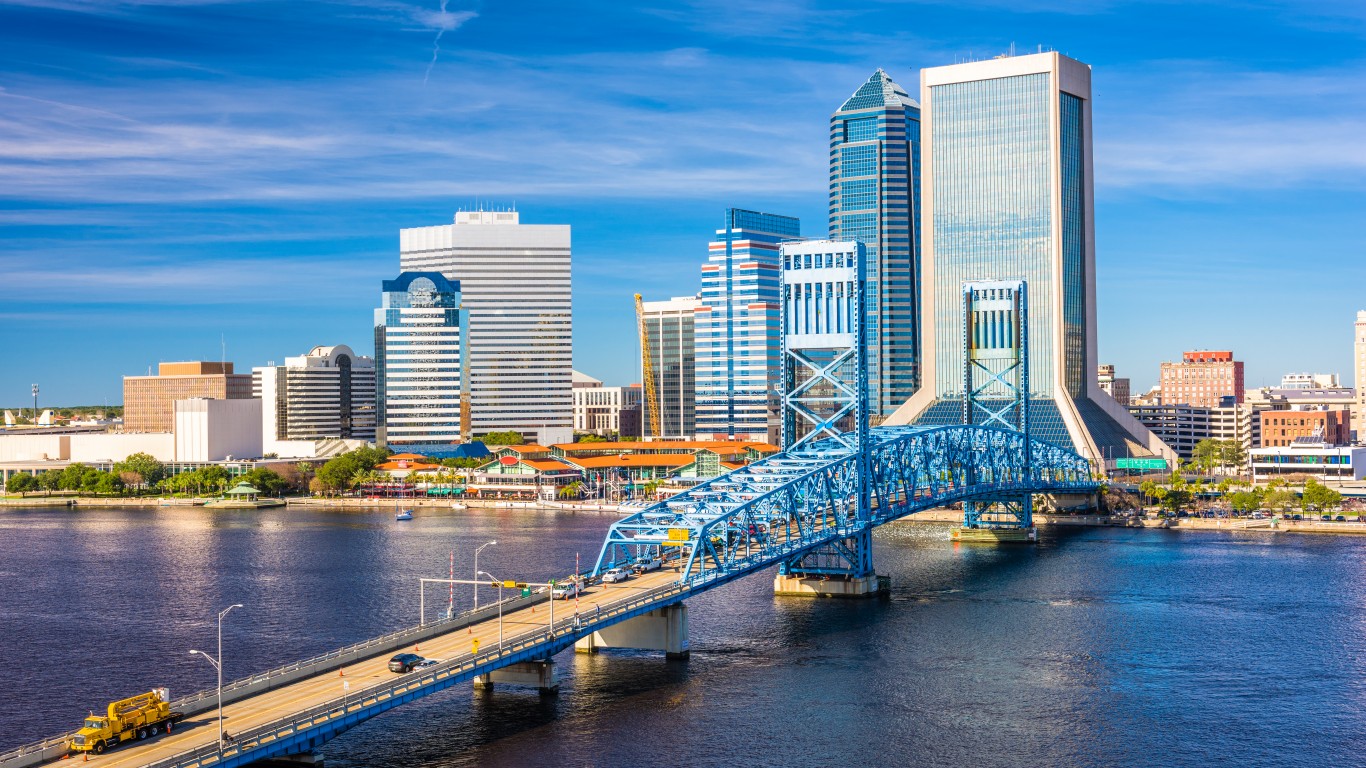
11. Jacksonville, FL
> Pct. of potential movers from outside Jacksonville, FL: 50.0%
> Top area people are searching from: Miami-Port St. Lucie-Fort Lauderdale, FL (16.6%)
> Cost of living: 4.5% less than nat’l avg.
> Median home value: $230,100
> Median household income: $65,880
One of many Florida metro areas to make this list, Jacksonville has had a substantial increase in home searches in each of the first three quarters of 2020.
Among Jacksonville residents looking for homes in the first three quarters of 2020 on Redfin, 75% were looking for homes within the metro area. But of all people looking to buy homes there, about half are from outside the city, with the largest share coming from the Miami-Port St. Lucie-Fort Lauderdale metro area.

10. Orlando-Kissimmee-Sanford, FL
> Pct. of potential movers from outside Orlando-Kissimmee-Sanford, FL: 52.8%
> Top area people are searching from: Miami-Port St. Lucie-Fort Lauderdale, FL (14.5%)
> Cost of living: 1.3% less than nat’l avg.
> Median home value: $255,500
> Median household income: $61,876
Amid the COVID-19 pandemic, the Orlando, Florida, metro area remained one of the most popular places for Americans to move, continuing a yearslong trend. From 2010 to 2019, the area’s population grew by 17.3% from net migration, the 15th highest percentage of all U.S. metro areas. The influx of people came largely from other Florida cities like Tampa and Miami, as well as farther north areas, like Washington, D.C. and New York City. New York state had among the largest shares of its population looking to relocate out of the state during 2020 amid the pandemic.
[in-text-ad]

9. Charlotte-Concord-Gastonia, NC-SC
> Pct. of potential movers from outside Charlotte-Concord-Gastonia, NC-SC: 39.6%
> Top area people are searching from: New York-Newark, NY-NJ-CT-PA (30.8%)
> Cost of living: 5.8% less than nat’l avg.
> Median home value: $233,900
> Median household income: $66,399
The Charlotte metropolitan area’s median household income of $66,399 is slightly higher than the U.S. median of $65,712. At the same time, the cost of goods and services in the area is 5.8% less expensive that the average across the country.
Like many metro areas with high numbers of people looking for homes in the area, the city has been a popular search destination for New York metro area residents. Over 30% of people searching for homes in Charlotte from outside the metro area have come from the New York metro area.
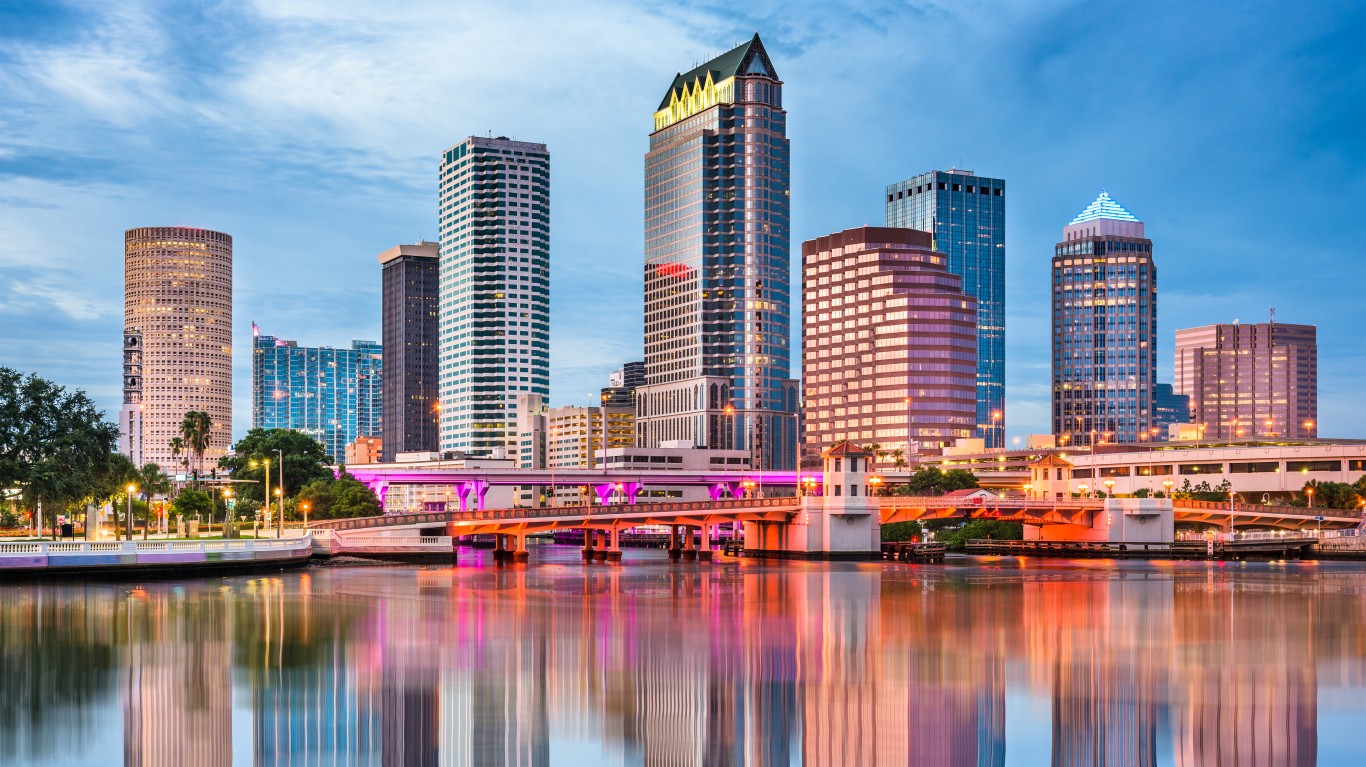
8. Tampa-St. Petersburg-Clearwater, FL
> Pct. of potential movers from outside Tampa-St. Petersburg-Clearwater, FL: 55.3%
> Top area people are searching from: Orlando-Lakeland-Deltona, FL (15.8%)
> Cost of living: 1.0% less than nat’l avg.
> Median home value: $224,300
> Median household income: $57,906
The Tampa metropolitan area population grew by nearly 400,000 people from 2010 to 2019 due to net migration, and it continued to be a popular relocation destination in 2020. Typically, most people looking for a place to live in a metro area already live in that metro, but in 2020, more than 55% of people who looked on Redfin for somewhere to live in Tampa did not live there. Orlando residents accounted for more people who looked to relocate to Tampa than residents of any other city.
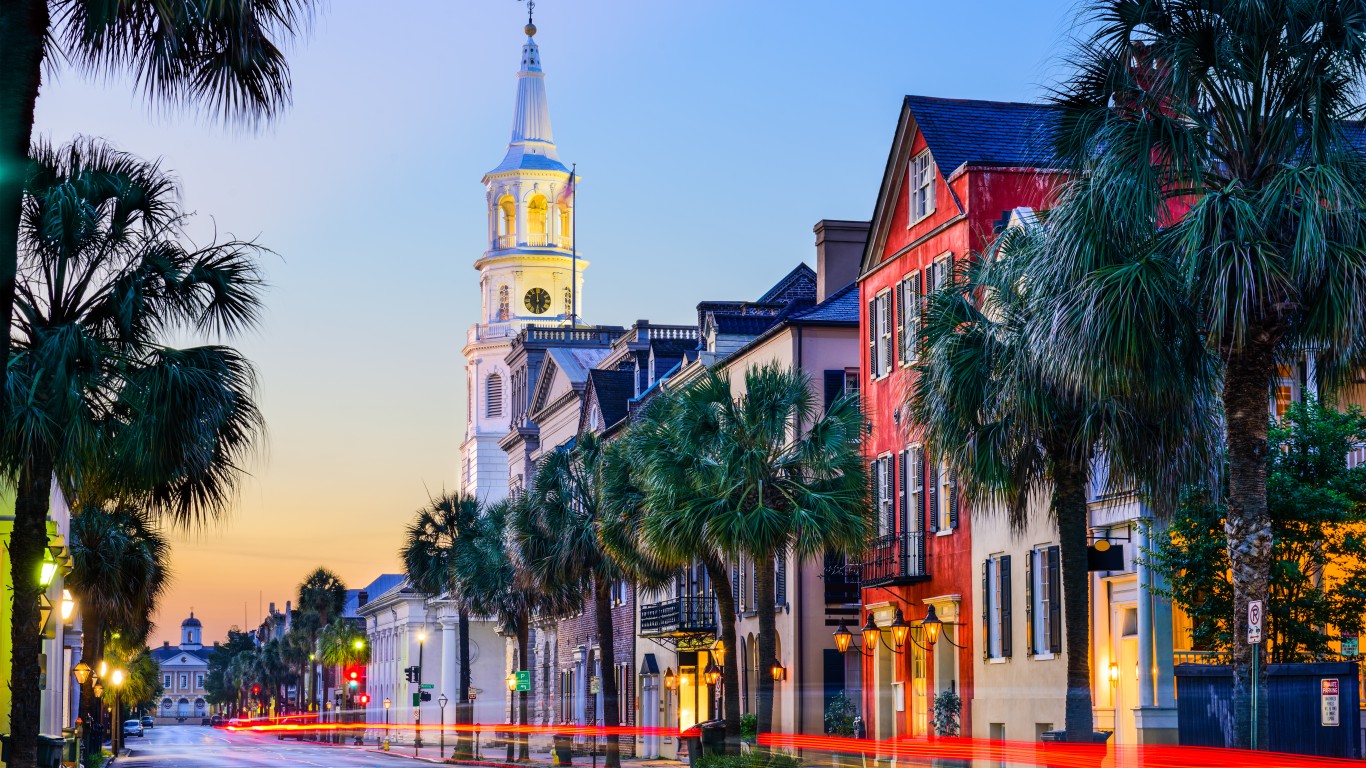
7. Charleston-North Charleston, SC
> Est. net population change, 2020 to date: +0.50% (+4,029)
> Pct. of potential movers from outside Charleston-North Charleston, SC: 48.8%
> Top area people are searching from: New York-Newark, NY-NJ-CT-PA (18.0%)
> Cost of living: 3.2% less than nat’l avg.
> Median home value: $266,600
> Median household income: $70,505
As New Yorkers left the city in droves throughout 2020, many cities in the South like Charleston were popular relocation destinations. More people from New York City sought to move to Charleston than those in any other city.
Charleston may have been an attractive option for people looking to move because homes there are relatively affordable, incomes are higher than the national median, and the cost of living is over 3% lower.
[in-text-ad-2]

6. Myrtle Beach-Conway-North Myrtle Beach, SC-NC
> Pct. of potential movers from outside Myrtle Beach-Conway-North Myrtle Beach, SC-NC: 75.7%
> Top area people are searching from: Washington-Baltimore-Arlington, DC-MD-VA-WV-PA (19.9%)
> Cost of living: 8.1% less than nat’l avg.
> Median home value: $212,100
> Median household income: $56,977
From 2010 to 2019, Myrtle Beach’s population grew by 32.6% from net migration alone, the second highest share among any major U.S. city. It continued to be a popular place for people looking to move in 2020. Typically, most people looking for a house in a major metropolitan area already live there, yet more than three-quarters of people looking to move to Myrtle Beach in 2020 did not. More people from the Washington D.C. area searched for homes in Myrtle Beach than people from any other place.

5. Phoenix-Mesa-Scottsdale, AZ
> Pct. of potential movers from outside Phoenix-Mesa-Scottsdale, AZ: 34.3%
> Top area people are searching from: Los Angeles-Long Beach, CA (24.1%)
> Cost of living: 1.9% less than nat’l avg.
> Median home value: $283,500
> Median household income: $67,896
The Phoenix metropolitan area, along with Tucson, is one of two Arizona cities to rank among the places Americans most want to move to in 2020. Nearly a quarter of people from outside the Phoenix area looking to move there searched from the Los Angeles area. Phoenix has consistently been one of the cities adding the most people through net migration over the past decade.
In addition to warm weather, the cost of living in Phoenix is lower than the overall U.S. cost of living, even though its median household income is over $2,000 higher than the U.S. median household income.
[in-text-ad]

4. Nashville-Davidson–Murfreesboro–Franklin, TN
> Pct. of potential movers from outside Nashville-Davidson–Murfreesboro–Franklin, TN: 37.8%
> Top area people are searching from: New York-Newark, NY-NJ-CT-PA (28.3%)
> Cost of living: 5.1% less than nat’l avg.
> Median home value: $285,100
> Median household income: $70,262
Though it is one of the most popular metro areas where people are looking to move, the majority of people using Redfin to look for a home in Nashville are in the Nashville area already. Nashville’s population grew by 17.5% from 2010 to 2019 due to net migration, one of the largest increases among all metro areas, and more than double the growth rate of the typical metro area.
Nashville has attracted the largest share of searches for housing from many of America’s largest metro areas, including New York City, Los Angeles, Chicago, and San Francisco.

3. Raleigh, NC
> Pct. of potential movers from outside Raleigh, NC: 34.1%
> Top area people are searching from: New York-Newark, NY-NJ-CT-PA (27.0%)
> Cost of living: 3.4% less than nat’l avg.
> Median home value: $285,600
> Median household income: $80,096
Raleigh is one of five metro areas at least partly in North Carolina to rank among the cheapest cities where Americans are looking to move. It is one of seven such cities in which New York City-area residents are looking to relocate more than residents of any other place, even though Raleigh is about 500 miles away.
The cost of living in Raleigh is 3.4% lower than the U.S. cost of living. At the same time, the area’s median household income of over $80,000 annually exceeds the U.S. median by more than $14,000.

2. Salisbury, MD-DE
> Pct. of potential movers from outside Salisbury, MD-DE: 91.9%
> Top area people are searching from: Washington-Baltimore-Arlington, DC-MD-VA-WV-PA (70.8%)
> Cost of living: 11.1% less than nat’l avg.
> Median home value: $244,400
> Median household income: $61,283
Typically, the people looking to relocate to the cities on this list from other areas are spread out relatively evenly between several metro areas. Those looking to relocate to the Salisbury, Maryland, metro area, however, are mostly from the Washington D.C. area, accounting from more than 70% of home searches. Just 8.1% of people who searched for a place to live in the Salisbury area in the third quarter of 2020 already lived in the area — the lowest share of any qualifying metro area.
The Salisbury area, near the southern tip of Maryland, is across the Chesapeake Bay from Washington, D.C. and about a two-hour drive away from the nation’s capital. Its cost of living is over 11% lower than the national average.
[in-text-ad-2]
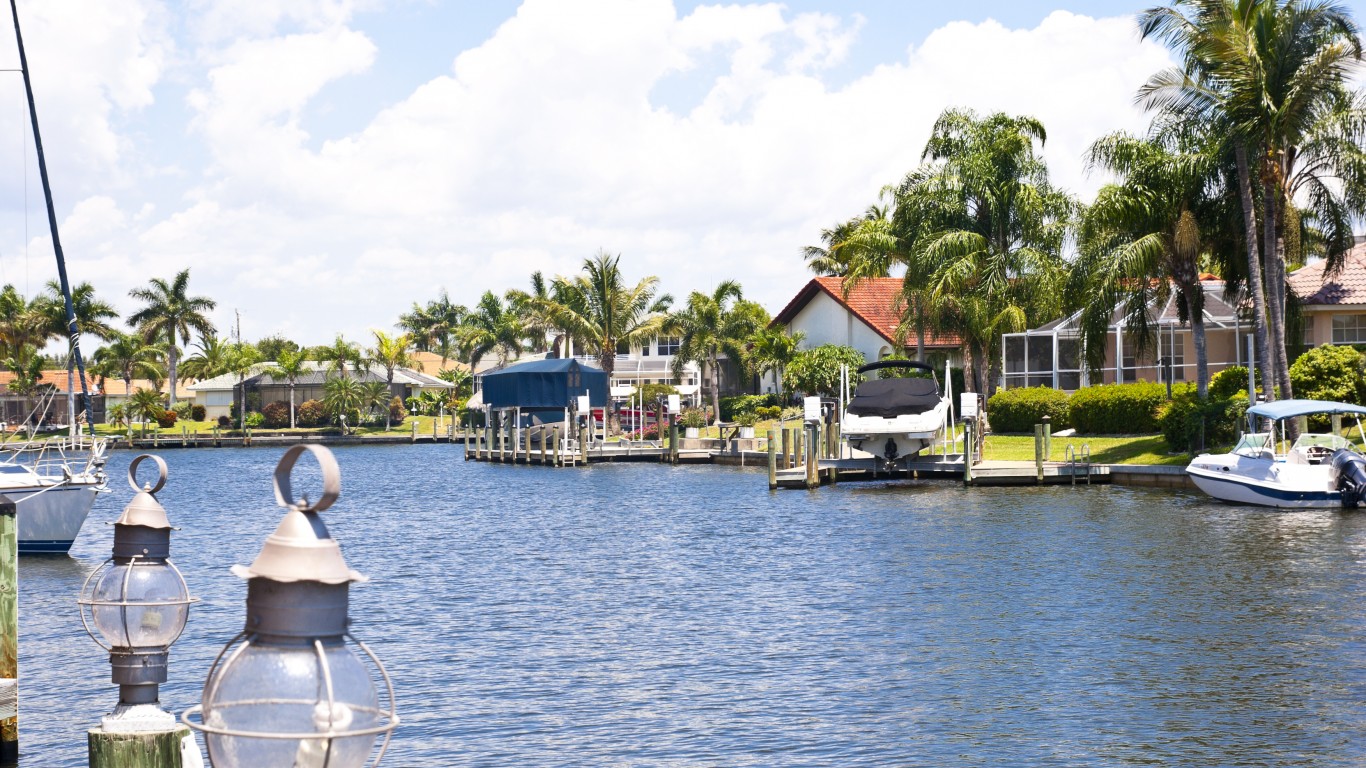
1. Cape Coral-Fort Myers, FL
> Pct. of potential movers from outside Cape Coral-Fort Myers, FL: 75.4%
> Top area people are searching from: Miami-Port St. Lucie-Fort Lauderdale, FL (15.7%)
> Cost of living: 2.2% less than nat’l avg.
> Median home value: $244,700
> Median household income: $62,240
The Cape Coral-Fort Myers metropolitan area tops the list of inexpensive cities where Americans are looking to move. In most places, the majority of people using Redfin to search for a home in a given metro area already live in that area, but more than three-quarters of people researching the Cape Coral area were searching from somewhere else. Miami residents searched more than those in any other metro area.
This continues a years-long trend of people moving to Cape Coral. The area’s population grew by nearly 25% due to net migration from 2010 to 2019. Cape Coral, and many other parts of Florida, have attracted new residents for years, a trend that continued into the pandemic.
Methodology:
To identify America’s cheapest cities where everyone wants to live, 24/7 Wall St. reviewed cost of living, housing affordability, and population growth from migration for 110 U.S. metro areas. We ranked cities based on the net incoming searches relative to outgoing searches for homes in each metro area among prospective buyers on Redfin.com, a national real estate brokerage, during the first three quarters of 2020 (January through September) as a percentage of the 2019 population. Population data came from the U.S. Census Bureau’s Population and Housing Unit Estimates program. Redfin’s net population inflow data is based on search activity among the site’s over 2 million users.
We only considered cities where the housing affordability ratio — the ratio of median home value to median household income — is less than the average across all metro areas of 4.25, and where the regional price parity — or cost of living — is below the national figure. Data on regional price parity is from the Bureau of Economic Analysis and is for 2018. Data on median household income and median home value came from the Census Bureau’s American Community Survey and are for 2019.
Want retirement to come a few years earlier than you’d planned? Or are you ready to retire now, but want an extra set of eyes on your finances?
Now you can speak with up to 3 financial experts in your area for FREE. By simply clicking here you can begin to match with financial professionals who can help you build your plan to retire early. And the best part? The first conversation with them is free.
Click here to match with up to 3 financial pros who would be excited to help you make financial decisions.
Have questions about retirement or personal finance? Email us at [email protected]!
By emailing your questions to 24/7 Wall St., you agree to have them published anonymously on a673b.bigscoots-temp.com.
By submitting your story, you understand and agree that we may use your story, or versions of it, in all media and platforms, including via third parties.
Thank you for reading! Have some feedback for us?
Contact the 24/7 Wall St. editorial team.